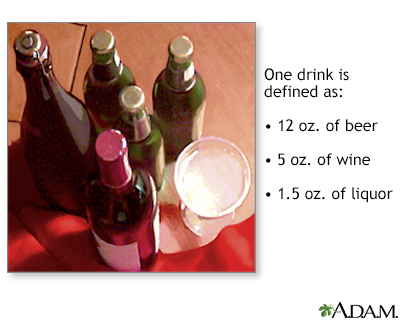Do you have a drinking problem?
Alcohol use disorder - drinking problem; Alcohol abuse - drinking problem; Alcoholism - drinking problem; Alcohol dependence - drinking problem; Alcohol addiction - drinking problem
Many people with alcohol problems cannot tell when their drinking is a problem or out of control. It is important to be aware of how much you are drinking. You should also know how your alcohol use may affect your life and those around you.
One drink equals one 12-ounce (oz), or 360 milliliters (mL), can or bottle of beer, one 5-oz (150 mL) glass of wine, 1 wine cooler, 1 cocktail, or 1 1/2-oz (45 mL) shot of liquor. Think about:
- How often you have an alcoholic drink
- How many drinks you have when you do drink
- How any drinking you are doing affects your life or the lives of others
Images

I Would Like to Learn About:
Responsible Drinking
Here are some guidelines for drinking alcohol responsibly, as long as you do not have a drinking problem.
Healthy men of legal drinking age should limit themselves to:
- No more than 2 drinks in 1 day
- No more than 14 drinks in a week
Healthy women of legal drinking age should limit themselves to:
- No more than 1 drink in 1 day
- No more than 7 drinks in a week
When you Start to Drink too Much
Health care providers consider your drinking medically unsafe when you drink:
- You are a man of legal drinking age who has 15 or more drinks a week, or often has 5 or more drinks at a time
- You are a woman of legal drinking age who has 8 or more drinks a week, or often has 4 or more drinks at a time
Knowing When you Have a Drinking Problem
You may have a drinking problem if you have at least 2 of the following characteristics:
- There are times when you drink more or longer than you planned to.
- You have not been able to cut down or stop drinking on your own, even though you have tried or you want to.
- You spend a lot of time drinking, being sick from drinking, or getting over the effects of drinking.
- Your urge to drink is so strong, you cannot think about anything else.
- As a result of drinking, you do not do what you are expected to do at home, work, or school. Or, you keep getting sick because of drinking.
- You continue to drink, even though alcohol is causing problems with your family or friends.
- You spend less time on or no longer take part in activities that used to be important to you or that you enjoyed. Instead, you use that time to drink.
- Your drinking has led to situations that you or someone else could have been injured, such as driving while drunk or having unsafe sex.
- Your drinking makes you anxious, depressed, forgetful, or causes other health problems, but you keep drinking.
- You need to drink more than you did to get the same effect from alcohol. Or, the number of drinks you are used to having now have less effect than before.
- When the effects of alcohol wear off, you have symptoms of withdrawal. These include, tremors, sweating, nausea, or insomnia. You may even have had a seizure or hallucinations (sensing things that are not there).
When to Call a Health Care Provider
If you or others are concerned, make an appointment with your provider to talk about your drinking. Your provider can help guide you to the best treatment.
More information and support for people with drinking problems and their families can be found at:
- Alcoholics Anonymous (AA) -- www.aa.org/
References
Centers for Disease Control and Prevention website. Alcohol use and your health. www.cdc.gov/alcohol/about-alcohol-use/?CDC_AAref_Val=https://www.cdc.gov/alcohol/fact-sheets/alcohol-use.htm. Updated May 15, 2024. Accessed June 19, 2024.
National Institute on Alcohol Abuse and Alcoholism website. Alcohol's effects on the body. www.niaaa.nih.gov/alcohols-effects-health/alcohols-effects-body. Accessed February15, 2024.
National Institute on Alcohol Abuse and Alcoholism website. Understanding alcohol use disorder. www.niaaa.nih.gov/publications/brochures-and-fact-sheets/understanding-alcohol-use-disorder. Updated January 2024. Accessed February 15, 2024.
O'Connor PG. Alcohol use disorders. In: Goldman L, Cooney KA, eds. Goldman-Cecil Medicine. 27th ed. Philadelphia, PA: Elsevier; 2024:chap 364.
US Preventive Services Task Force. Screening and behavioral counseling interventions to reduce unhealthy alcohol use in adolescents and adults: US Preventive Services Task Force recommendation statement. JAMA. 2018;320(18):1899-1909. PMID: 30422199 pubmed.ncbi.nlm.nih.gov/30422199/.
BACK TO TOPReview Date: 2/8/2024
Reviewed By: Linda J. Vorvick, MD, Clinical Professor, Department of Family Medicine, UW Medicine, School of Medicine, University of Washington, Seattle, WA. Also reviewed by David C. Dugdale, MD, Medical Director, Brenda Conaway, Editorial Director, and the A.D.A.M. Editorial team.

Health Content Provider
06/01/2025
|
A.D.A.M., Inc. is accredited by URAC, for Health Content Provider (www.urac.org). URAC's accreditation program is an independent audit to verify that A.D.A.M. follows rigorous standards of quality and accountability. A.D.A.M. is among the first to achieve this important distinction for online health information and services. Learn more about A.D.A.M.'s editorial policy, editorial process and privacy policy. A.D.A.M. is also a founding member of Hi-Ethics. This site complied with the HONcode standard for trustworthy health information from 1995 to 2022, after which HON (Health On the Net, a not-for-profit organization that promoted transparent and reliable health information online) was discontinued. |
The information provided herein should not be used during any medical emergency or for the diagnosis or treatment of any medical condition. A licensed medical professional should be consulted for diagnosis and treatment of any and all medical conditions. Links to other sites are provided for information only -- they do not constitute endorsements of those other sites. © 1997- 2025 A.D.A.M., a business unit of Ebix, Inc. Any duplication or distribution of the information contained herein is strictly prohibited.
